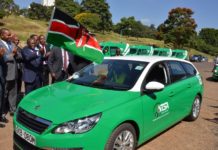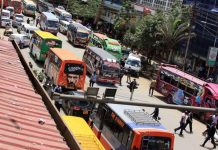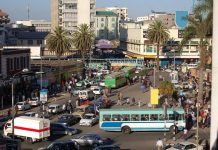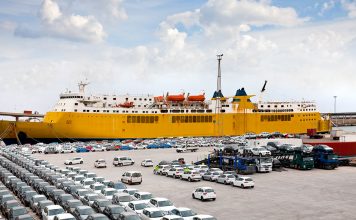The Friday arrest of three people suspected of hacking into the National Transport and Safety Authority (NTSA) website brings to the fore the government’s lack of keenness to end the fake number plates menace.
The government has, since 2015, been planning to produce new-generation number plates that would be impossible to copy.
The proposed plates would have anti-counterfeit features that include holograms, watermarks, and laser markers which, if implemented, would provide the necessary checks against double registration of cars.
When they were arrested in Ngara, Nairobi, Michael Onyango Oduor, 54, and Sylvester Onyango, 30, were found actively trying to hack the NTSA website and the Transport Information Management System (TIMS). The third suspect, 33-year-old Antony Rugut Korir, was picked at NTSA offices where he works at the call centre.
He is suspected to have been assisting the hackers to access the NTSA network.
After the arrest, detectives recovered Sh1.18 million in 100 US dollar bills, three motor vehicles and a fibre laser cutting machine used to cut number plates.
A compressor machine that was being used for painting number plates, one number plate, five desktop computers, laptops, logbooks, modems, hard drives and flash drives were also recovered.
But even as the NTSA grapples with the fake number plates’ menace, the correctional services department under the same Interior ministry is on the spot for failure to initiate production of the new-generation number plates.
The government has, for the past five years, been seeking to replace the current plate production system, whose loopholes crooks have exploited to steal cars or dump cars meant for export in the country.
The current system produces 1,000 pairs of licence plates per day, as opposed to a new generation system that could make 6,000.
In 2015, the state department for correctional services advertised for the supply of raw materials for number plate blanks and hot stamping foils.
However, the tender was challenged in court and the matter was finally settled in 2017.
The Attorney General advised that the tender be awarded to the initial winners as per the High Court ruling.
President Uhuru Kenyatta visited Kamiti Prison in February 2017 and was shown machines for the new generation number plates.
In March 2019, the parliamentary committee on security also made a similar visit, but not much has been heard from the government since then.
Despite the noble plans, the old number plates continued to be issued. The reason given is that the laser marking machine is yet to be delivered.
Sources indicate the machine was ordered in 2018 but the firm that won the tender, Tropical Technology Limited, is yet to deliver.
According to sources in the prisons department, the company declined to deliver the machine despite having imported it after the prisons department declined to issue a local purchase order.
“Production and roll-out of new-generation number plates was rescheduled to commence on July 1, 2018, but could not be executed until the process of procuring the laser marking machine – which is for validating licence plates – had been concluded. “In July 2019, the department of correctional services declined to accept a consignment of number plate blanks from Tropical Technology in fulfillment of their order, even though it had accepted the previous two consignments from the company,” said a source.
Last year, the government sent a delegation to Germany with the aim of buying a new machine but, according to sources, they were advised that the machine they were looking for produces 30 million plates a year and would require several countries to come together.
NTSA was hived off the Kenya Revenue Authority in 2012. According to sources, the move delinked the entire vehicle importation, declaration, inspection and registration process with disastrous consequences to the security of the country.
“Now importers and motor vehicle dealers do not fear or bother about KRA in their schemes to import and declare motor vehicles as transit goods meant for South Sudan, Rwanda or Congo.
“Once they get to Busia or Malaba border, the cars are hidden, the paperwork is perfected, transit bonds cancelled and customs entry into Kenya is retired and archived.
“The crooks create a fictitious entry in the system and take them to NTSA.
“The fellows in ICT at NTSA deploy a malware or manipulate the registration system to allow the insertion of special characters such as dots, commas and apostrophes during the input of the chassis number.
“The TIMS can’t detect that the chassis number is for a motor vehicle that was meant for transit to a second country,” said the source.
The most lucrative cars are those with high-engine capacity such as Range Rover, Toyota Prado, Audi, BMW, Porche and Jaguar.
They are illegally diverted to the local market and registered without paying tax.
Insiders said separating the vehicle importation process from registration was a big mistake.
NTSA should have been left to manage the licensing, registration and transfer of vehicles from one owner to another.
“The delay in implementing the new number plate registration process is deliberate. KRA is forced to release cars from Mombasa port before they have number plates, which gives crooks at the NTSA leeway to tamper with the declaration and registration process,” said another source.
Efforts to get a comment from NTSA Director-General George Njao were fruitless as our calls and text messages went unanswered.
Last week, the National Police Service disclosed that it was trying to impound about 450 vehicles registered illegally to evade paying tax.
Unscrupulous businessmen colluded with rogue employees to infiltrate the NTSA website and fraudulently register vehicles.
NTSA admitted that its database had been infiltrated and that some vehicles got into the system without following the laid-down procedures.
NTSA, in a statement, listed 37 names of individuals and companies whose data was used to register vehicles fraudulently.
The scandal raises questions on the safety of motorists’ data in the TIMS register.
Just last year, the then Interior CS Fred Matiang’i called for investigations after it emerged that some NTSA employees had colluded with KRA officials and car dealers to clone car number plates.
One of the cars with duplicated plates was used during the Dusit D2 attack.
The NTSA circular listed 42 vehicles issued with new number plates when they were destined for other countries including South Sudan, Uganda, Malawi, Uganda, Burundi, the DRC and Tanzania.
Last year, police impounded hundreds of vehicles after it emerged that their number plates had been cloned or they were fraudulently registered.
Some 19 NTSA employees were arrested in connection to the plate-cloning ring but they were later released.
SOURCE: nation.co.ke







![Top 20 Used Cars to Avoid Buying in Kenya – [PHOTOS]](https://kenyacarbazaar.com/blog/wp-content/uploads/2013/11/top-used-unreliable-cars-to-avoid2-80x60.jpg)

![Here are some of the best tuned cars in kenya by state of the art garages [PHOTOS]](https://kenyacarbazaar.com/blog/wp-content/uploads/2013/11/29402_10151301757042065_340470732_n-e1384498044289.jpg)



![Top 20 Used Cars to Avoid Buying in Kenya – [PHOTOS]](https://kenyacarbazaar.com/blog/wp-content/uploads/2013/11/top-used-unreliable-cars-to-avoid2-100x70.jpg)






